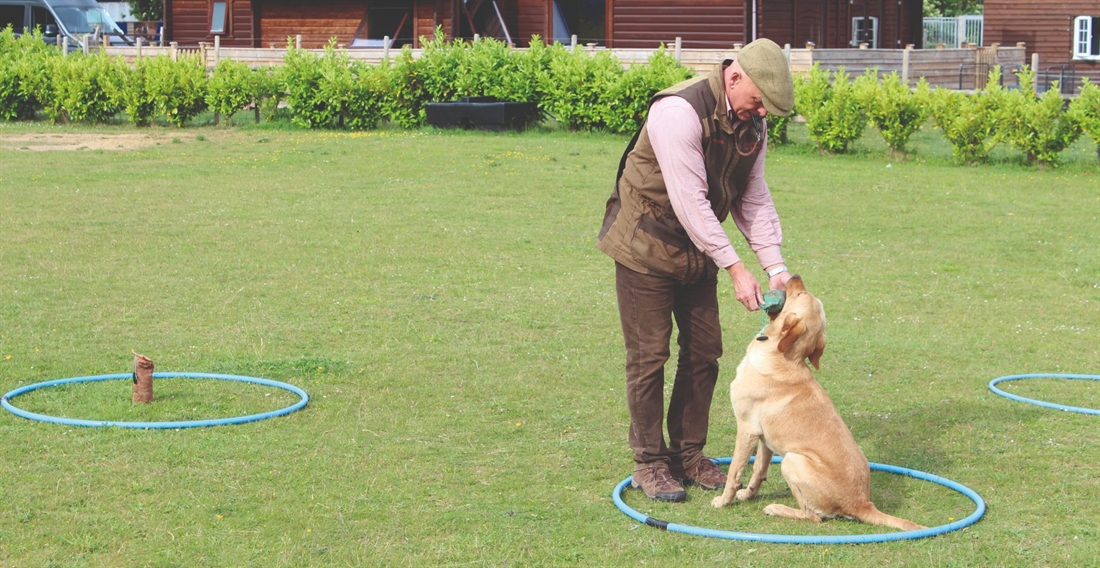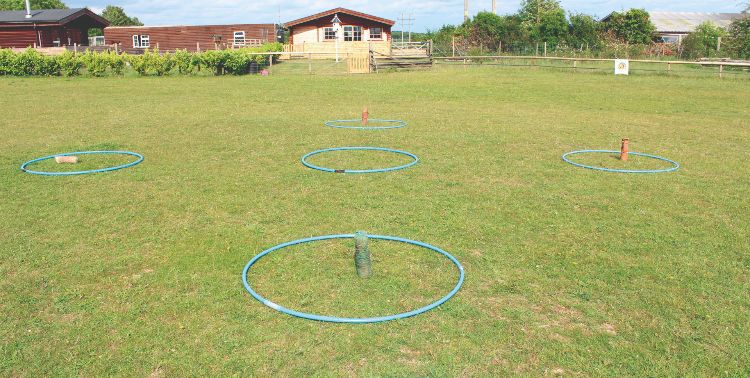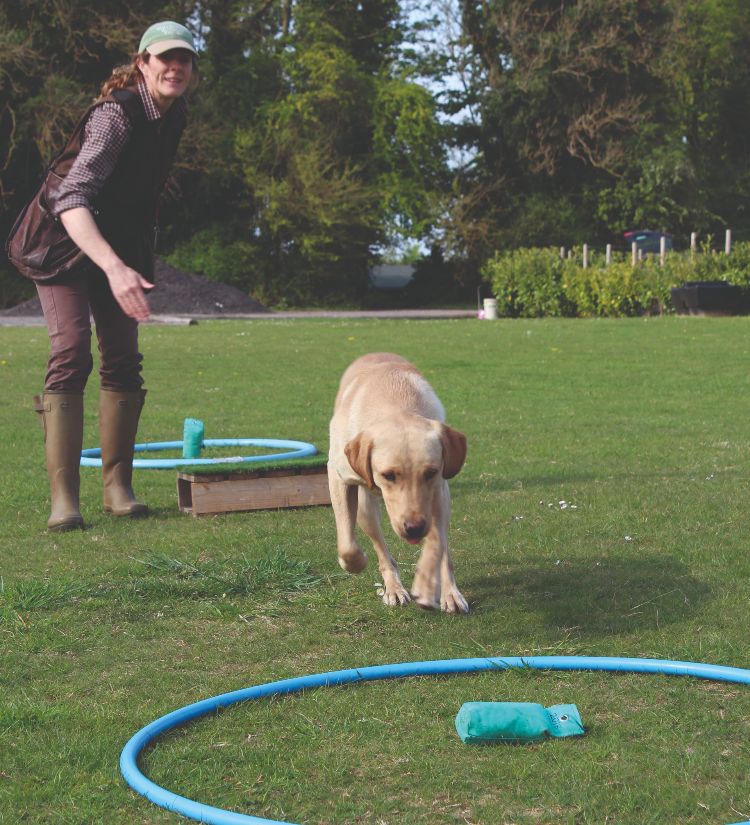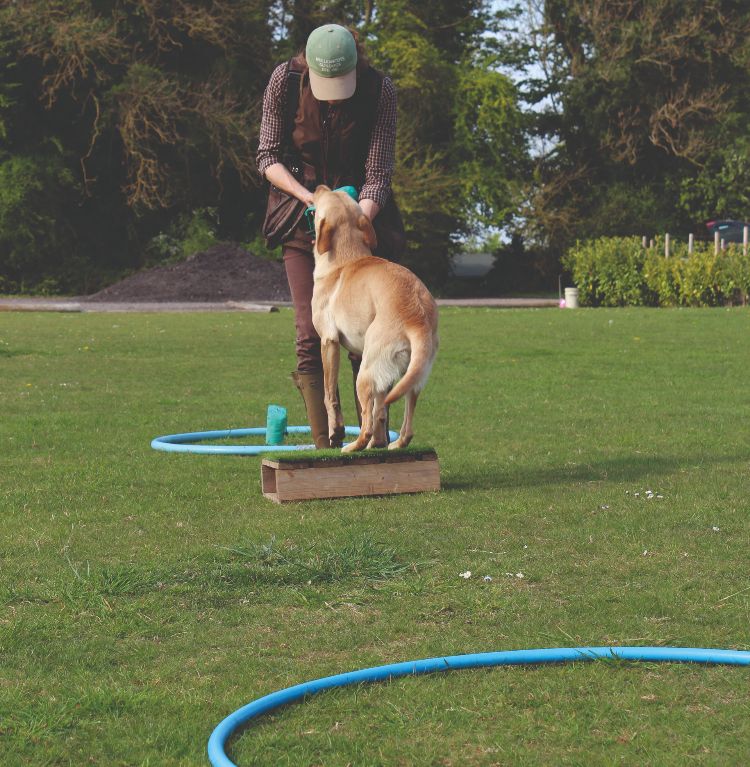Directional training: The Clock Face
Gundog trainer Howard Kirby explains how to use the clock face for a set of time- and space-efficient retrieving exercises to help cement directional commands.

To ensure that behaviours such as taking left, right, back and recall retrieves are thoroughly learned, a period of essential consolidation is really important – and often overlooked. Assuming that all has gone to plan, I thought I’d share a set of exercises with you that doesn’t require a lot of space, or time.
 Building the ‘clock face’
Building the ‘clock face’
We can use the design of a clockface as a layout to consolidate and build a really positive understanding of directional commands. Think of the four main clock points in the following way:
- 12 o’clock = Go Back
- 3 o’clock = Go Right
- 6 o’clock = Come towards me
- 9 o’clock = Go Left
To make sense of all this, imagine your dog is sat smack bang in the middle of the clock.
The size of this clockface can be as big or small as you wish. A nice size to begin with is a circle with 10 big paces in all directions from the dog. In grown-up language I think that’s a 10-pace radius. Hopefully you’ve got the picture.
 How to do it
How to do it
Let’s start by sitting the dog in the middle and throwing a dummy to its left and right (9 and 3 o’clock). Immediately our first consideration is how far away are we going to stand from the dog? This can make a considerable difference to the outcome of this exercise. Our long-term objective is that we can be upwards of 100 yards away and the dog have an understanding of the directional signals we give. Play safe, 10 paces will do for now.
Blow your Stop whistle. This announces, “hey look up I’m going to send you for a retrieve.” We’re going to send the dog to the first dummy we threw out. This is referred to as ‘the first dummy down.’ Wait until the dog is really focusing on you and then send it using a clear command. Because of the training and preparation that we’ve done up to this point, this retrieve should be straightforward. Once delivered to hand, heel the dog back out to the centre and throw the dummy that’s just been picked, back out to 9 o’clock.
Be clear in your mind that throwing this dummy back out serves not only to add distraction but also difficulty. On each and every occasion that something takes your dog’s focus, it will make it just that little bit more difficult for them to recall the dummy that we threw to 3 o’clock.
This is not necessarily a bad thing – in fact, we are deliberately using this exercise to keep the dog thinking. Done correctly we can improve the dog’s ability to remember and mark the fall of dummies or birds. However, the reason I’m mentioning this is that whilst the clockface is a nice exercise to develop a dog’s skills, it is not uncommon for handlers to accidentally rush the number of dummies that are put out at any one time. This will create confusion in the dog’s mind.
In previous articles, we talked about training the dog that is in front of you. Take my word for it, if you rush and create confusion you will quickly undermine the dog’s confidence to make decisions. Even though we are working with a young dog, these formative exercises and stages in the dog’s development are likely to shape its approach and long-term working ability. We are trying to encourage a confident, forward-going dog that chooses to co-operate with you. This is not as straightforward as it sounds.
Your dog’s nature and its nurture up to this point will influence the way it behaves. In a young dog that is going through its various stages of maturity, you may see considerable changes in its behaviour and attitude. Sometimes it will feel like things have changed overnight.
I have seen some very bold and strong retrieving dogs reduced to choosing to just sitting in the middle of the clockface. They were simply so confused and concerned about getting things wrong that doing nothing seems to be their only option. In all cases, these dogs were not being trained by owners that you would accuse of being cruel handlers. To avoid this, you need to be sure that you do not rush the process.
 Clarity first
Clarity first
All of that said, I do like to mix things up a bit. So I concentrate on teaching a dog to be really confident to understand the difference between left and right and then I move on to placing the pair of dummies at 12 o’clock (‘the Back’), and 6 o’clock (‘the Recall’) retrieve. These two separate exercises ensure that dummies are always 180º apart. This of course helps with clarity for the dog and reduces the risk of confusion.
Now we can ‘change things up’ and set dummies that are set at 90º apart. For example, one at 12 o’clock and one at 9. This now raises the degree of difficulty quite considerably. You might choose to reduce your distance from the dog, maybe setting yourself up only a few paces away.
Whilst we are still only using two dummies, this presents an ideal opportunity to teach a young dog to be aware of which arm you are using to give the ‘Back’ command. With dummies at 9 and 12, we can place the dog in the middle of the circle orientating him slightly towards 3. Our aim is to send the dog back to 12, but engineering that he turns away from the nine as he lifts to ‘go back.’ Give the directional command using your right arm. There is a real danger that when described in written word, this element of training becomes confusing, so I’m not going to labour this too much at this point. Our aim is that when sent on a ‘Back’ command that our dog will always peel off to the right if we use our right arm and to the left when this arm is used.
In conclusion, if we carefully school our young retrieving dogs to be able to cope with four dummies that are carefully positioned on our imaginary clockface, and to confidently take directional commands that see the dog retrieving whichever dummy we ask for, we are well on our way to a dog that will be exciting to watch when being handled on the shooting field. Let’s not rush this though. Be patient and clear. And if your dog is getting it wrong or looking confused, take a breath.
We talked about self-assessment last month, but it’s even better to get an experienced handler to keep an eye on your progress. Keep reminding yourself that this is something you should be enjoying. The key is that you ensure your dog is also having a great time. Get this right and you’ll be able to enjoy the progress the pair of you make.
As always, remember that time with your dog is precious. Have fun and Keeeeeeep Training!




 Building the ‘clock face’
Building the ‘clock face’ How to do it
How to do it Clarity first
Clarity first
